EXSC 352 Exam 1 Review
1/90
Earn XP
Description and Tags
Exam 1 Review for Exercise Physiology
Name | Mastery | Learn | Test | Matching | Spaced |
|---|
No study sessions yet.
91 Terms
What are the main substrates used as fuel during exercise
Carbs, Fats, Proteins
How many kcals/gram are in Carbohydrates, when is it used?
4.1 kcal/gram, primary ATP substrate
How many kcals/gram are in Fats, when is it used?
9.4 kcals/gram, used for prolonged exercise
How many kcals/gram are in Protein, when is it used?
4.1 kcal/gram, used in lipogenesis
How much glycogen is in the body
Liver (110 g), muscle (500 g), body fluids (15)
How much fat is stored in the body
Subcutaneous (7,800 g), visceral (161 g), body fluids
What is ATP
Stored energy in small amounts until needed
How do we get energy from ATP
Breakdown of ATP, ADP + Pi is energy
What are the three ATP Synthesis Pathways
ATP-PCr system (Anaerobic)
Glycolytic system (Anaerobic)
Oxidative system (Aerobic)
What is ATP-PCr system energy system, how long does it last? What is the yield?
3-15s, 1 mol ATP / 1 mol PCr
Anaerobic system
What is the ATP PCr recycling
PCr + Creatine Kinase creates Creatine, Pi, and Free Energy
Free Energy + Pi + ADP = ATP
What is Glycolytic energy system, how long does it last? What is the yield?
15s-2 min, 2-3 mol ATP / 1 mol substrate
Anaerobic System
Glucose or glycogen as a substrate we use Glucose-6-phosphate and a pyruvic acid, how many enzymatic reactions occur, where does it occur, and what is the ATP yield for glucose and glycogen?
10-12 enzymatic total reactions
Occurs all in the cytoplasm
ATP Yield: Glucose 2 ATP, Glycogen 3 ATP
What is glycolysis
Breakdown of glycogen into glucose
Used under 2 minutes max during exercise
Cons of the Glycolytic System
Low ATP yield
Inefficient use of the substrate
Low O2 converts pyruvate to latic acid
Lactic acid impairs glycolysis causing muscle contraction
Pros of Glycolytic System
Allows muscle to contract with low O2
Short-term, high-intensity exercise when oxidative metabolism sustains energy
What is Phosphofructokinase (PFK)
Rate limiting enzyme
Low ATP (Increased ADP) → Increase PFK activity
Increase ATP → Decrease PFK activity
What is the Oxidative energy system, how long does it last? What is the ATP yield?
Aerobic system
Can last for hours
ATP yield: 32-33 ATP / 1 glucose
ATP: 100+ ATP / 1 FFA
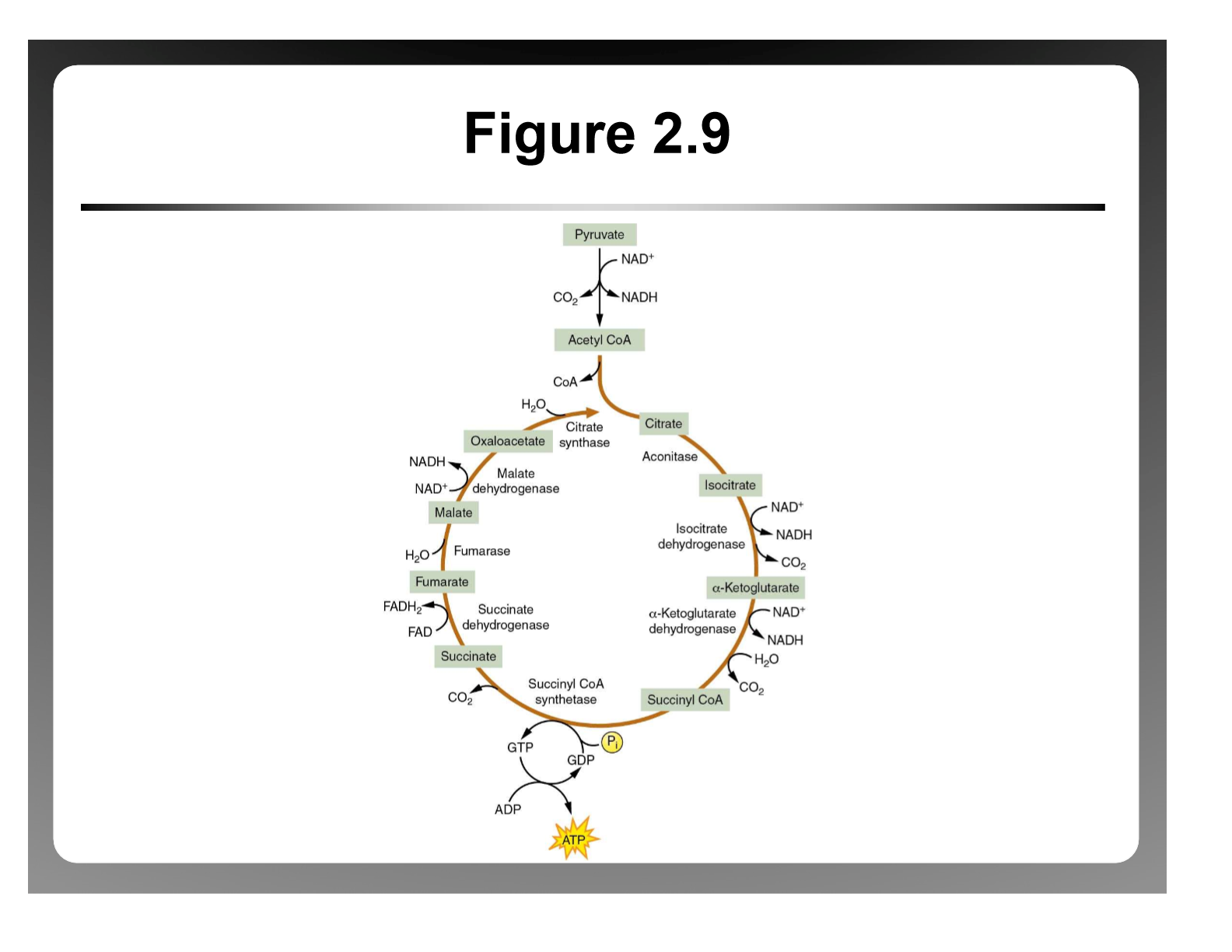
What is the Krebs cycle? What is the Ratio? What does 2 acetyl-CoA create? What is the ATP Yield
Krebs Cycle: Creation of ATP energy
1 Molecule of Glucose → 2 acetyl-CoA
2 acetyl-CoA → 2 GTP → 2 ATP
ATP Yield: 1 glucose → 32 ATP / 1 glycogen → 33 ATP
What are the broken down totals of the Krebs Cycle
Glycolysis = +2 ( or +3) ATP
GTP (Transports Pi to ADP) = +2 ATP
10 NADH = +25 ATP
2 FADH = + 3 ATP
How does fat enter the Krebs Cycle
Lipids go through Beta-Oxidation and is added to the Acetyl-CoA during Krebs
What is the electron transport chain? How is ATP created? What is the ATP yield?
H+ and electrons are carried to ETC via NADH and FADH molecules
H+ travel down the chain combining with O2
Electrons and O2 create ATP
NADH: 2.5 ATP
FADH: 1.5 ATP
What is lactate acid, what are the three pathways
Fuel for exercise
Cytoplasm
Transported to another cell
Liver
What is the lactate acid pathway in the cytoplasm
Taken up by mitochondria of the same muscle and is oxidized
What is the lactate acid pathway into another Cell
Transported by MCP transporters and is oxidated there
What is the lactate acid pathway in the liver
Recirculated into the liver to be converted back into pyruvate, then to glucose (via gluconeogenesis)
What is the Respiratory Exchange Ratio (RER)
Volume of both CO2 and O2 that is produced
RER = VCO2 / VO2
What does it mean when the RER is around 0.7
Gluconeogenesis is produced at an RER of <0.7
What does it mean when the RER is around 1.0
Can be inaccurate when lactate buildup increases over the CO2 exhalation
What is fatigue
Inability to maintain required power output at a given intensity
Fatigue Causes
Inadequate energy delivery
Accumulation of by-product
Failure of muscle contraction
Altered neural control
Fatigue Recovery
Rest
Fatigue from PCr Depletion
Phosphorus accumulation
PCr gets depleted faster than ATP
Fatigue from Glycogen Depletion
Limited and gets depleted quickly
Depletes faster at a higher intensity
FFA Oxidation is slow
What are the metabolic by products
Pi: From PCr and ATP
Heat from sweat
Carbs from heat
Lactic Acid from glycolysis
What is direct calorimetry
Measurement of Calories over time, good for RMR measurements
It is expensive and slow, heat can be added by exercising, sweat can cause errors
What is Neural Transmission fatigue
Failure of muscle activation (Cramp)
What is CNS Fatigue
Stress from exercise taxing the CNS
Discomfort of fatigue
What is indirect calorimetry
Estimate of total energy expenditure via O2 and CO2 production, accurate only with a steady-state of oxidative metabolism
Old methods are accurate but slow
What are the three types of muscle tissue
Skeletal, Smooth, Cardiac
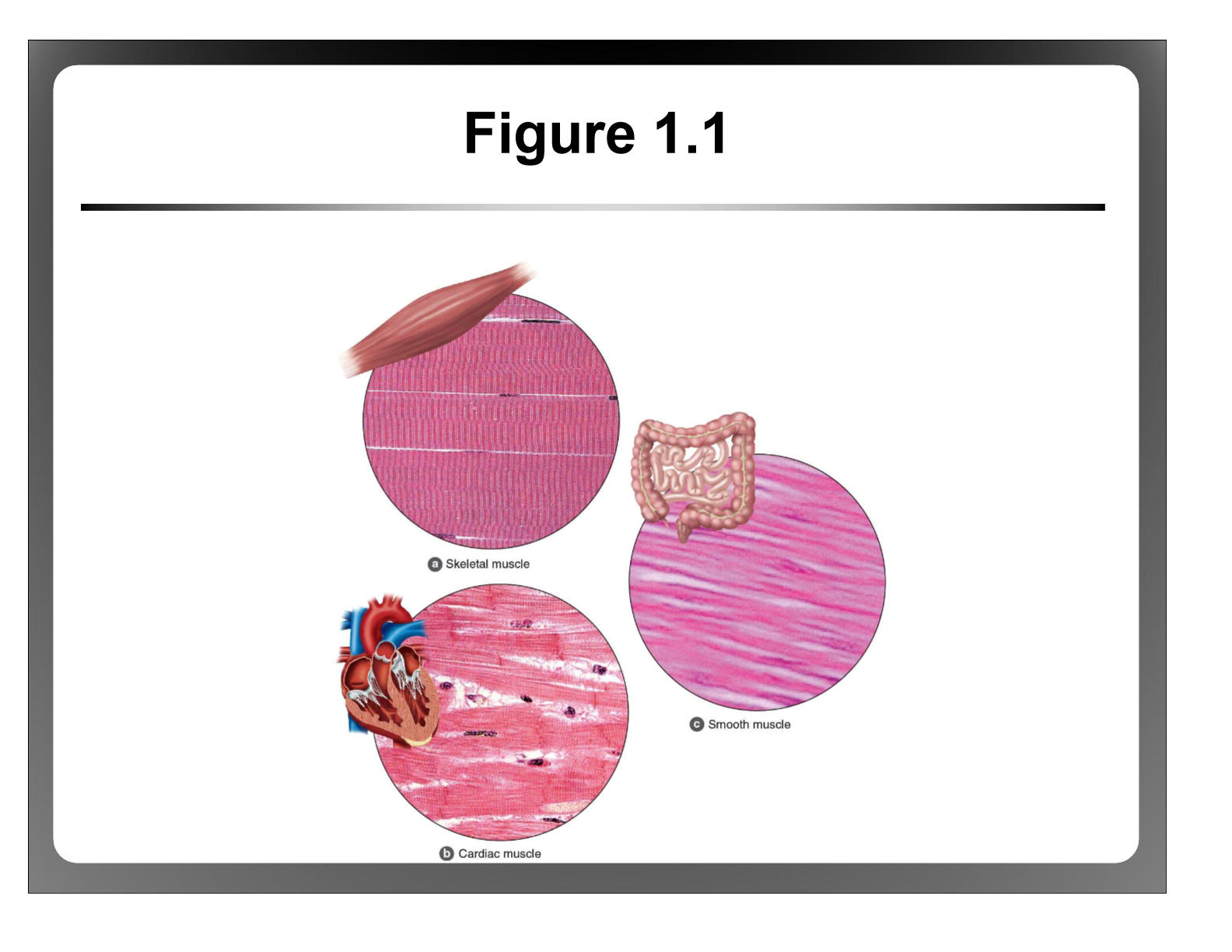
What is the anatomy of the entire muscle
Surrounded by Epimysium
Made up of fasciculi
What is the anatomy of Fasciculi
Surrounded by perimysium
Made up of muscle fibers
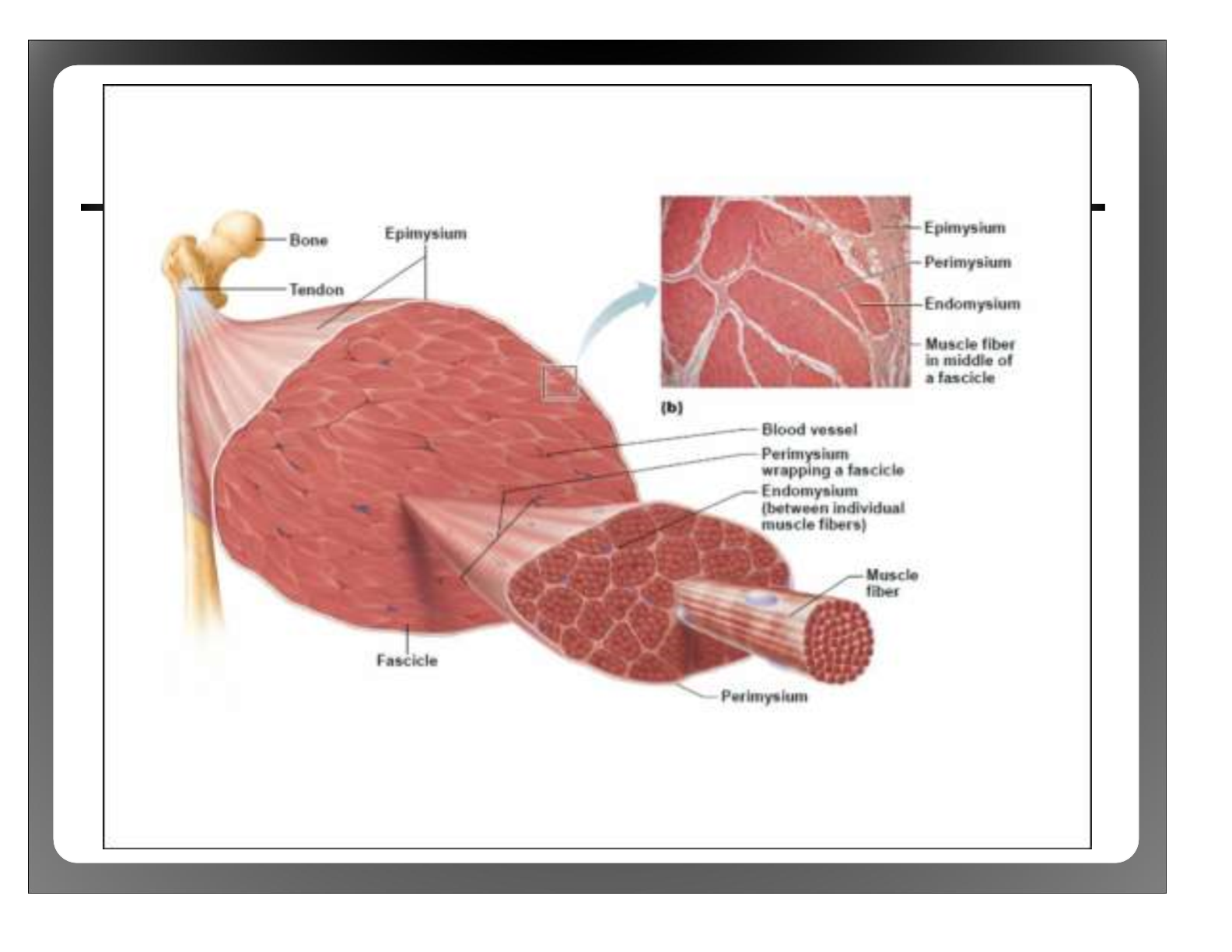
What is the anatomy of muscle fiber
Surrounded by endomysium
Made of myofibrils (sarcomeres)
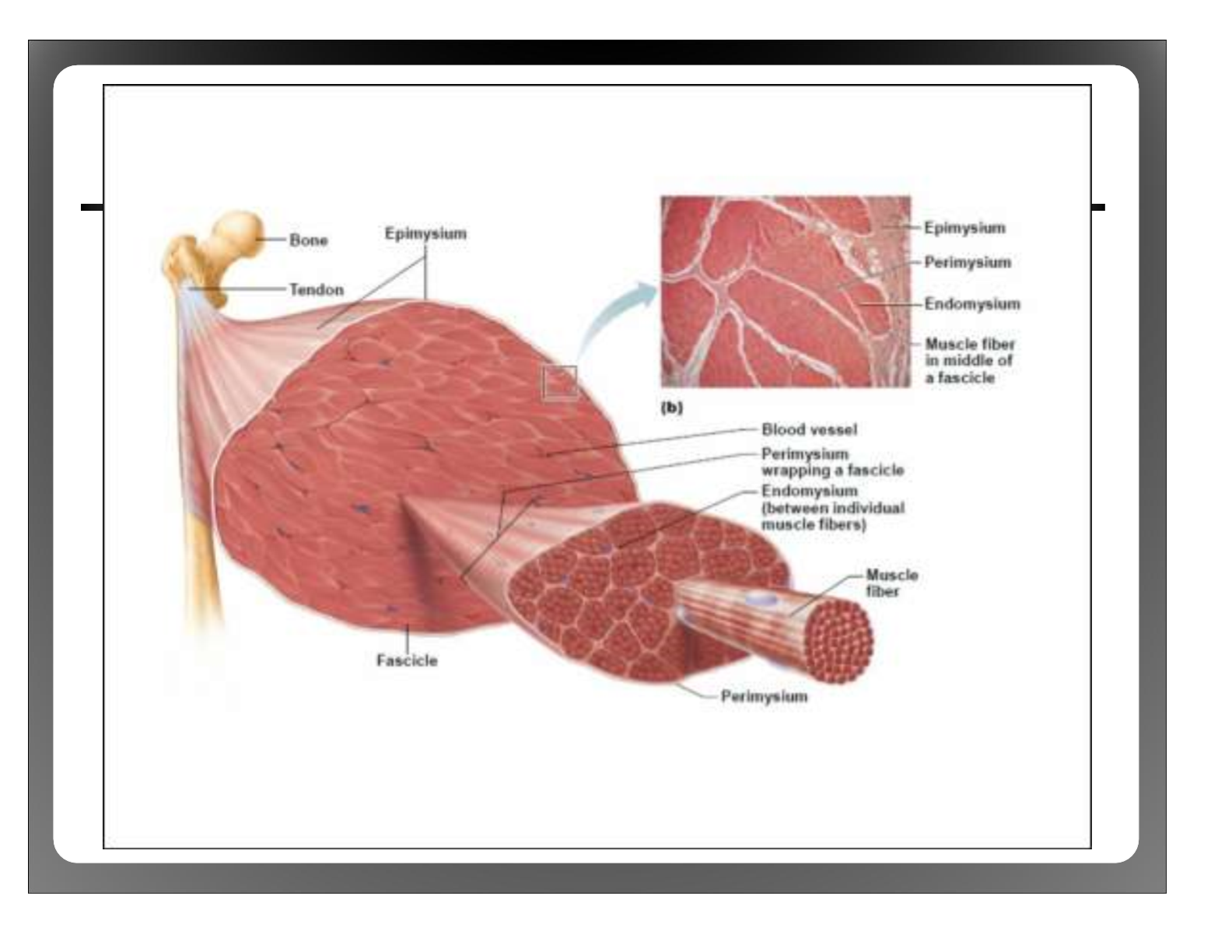
What is the structure of the Cell Membrane (Plasmalemma)
Fused with the tendon that conducts the Action Potential (AP), it maintains the pH levels and transports nutrients
What are satellite cells? What do they help do?
They promote muscle growth and development
Helps with injury, immobilization, and training
The Sarcoplasm serves as? What is its unique features
Serves as cytoplasm of the muscle cell
Unique Features: Glycogen storage and myoglobin
What are the transverse tubules (T-Tubules)
Serves as extension of the Cell membrane
Carries the AP deeper into the muscle fibers
Why is the Sarcoplasmic reticulum (SR) unique
Ca2+ storage
What is the pathway of the myofibrils and how many are there?
Muscle → Fasciculi → muscle fiber → myofibril
Contains over +100K per muscle fiber
What is a sarcomere
Basic contractile element of the skeletal muscle
Know the structure of a muscle fiber and sarcomere
Be able to label the following:
A-band → Dark stripes
I-Band → Light stripes
H-Zone → middle of the A-Band
M-Line → Middle of H-Zone
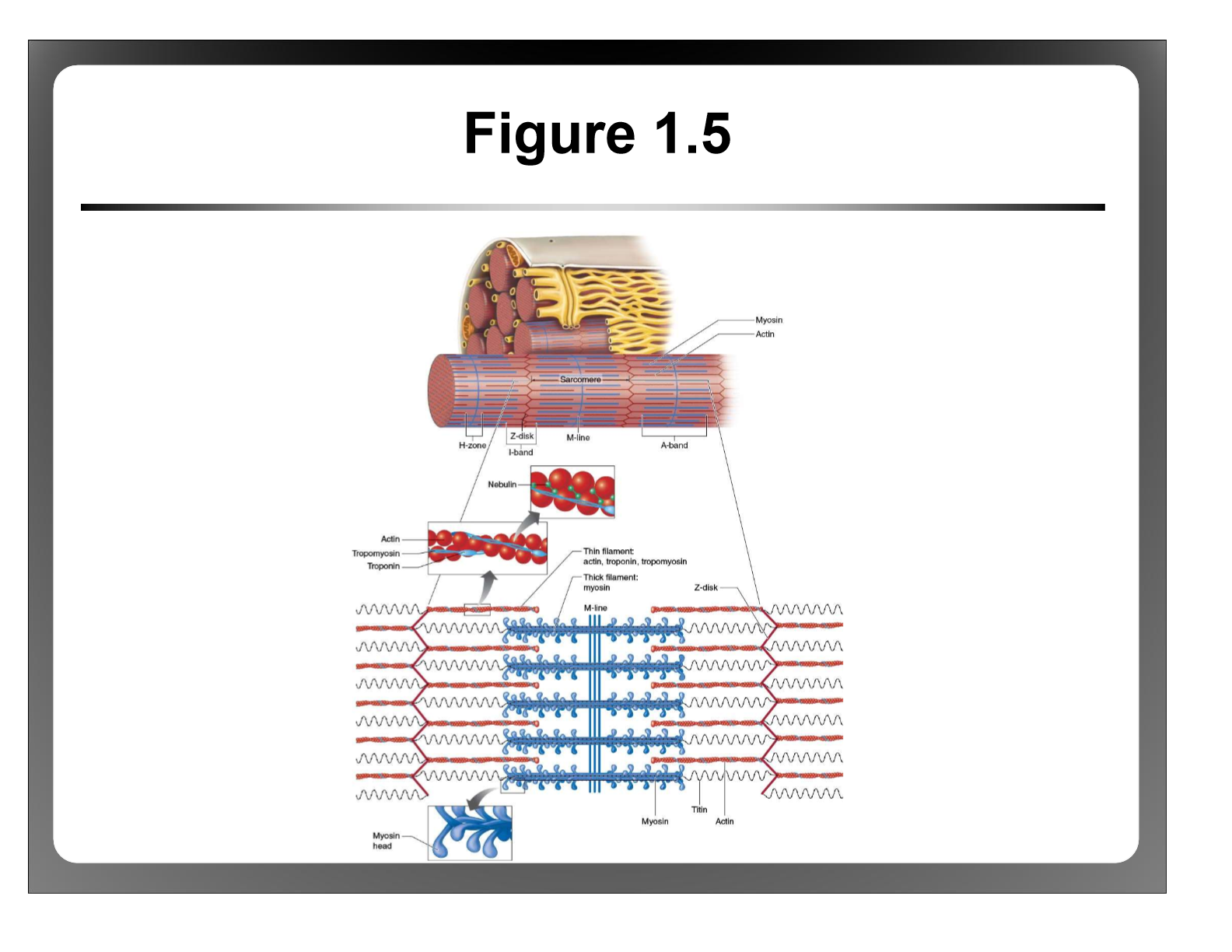
What are the three myofilaments
Actin, Myosin, Titan
What is Myosin (Thick Filaments), what does it use as a stabilizer
Two intertwined filaments
Contains Globular Heads
→ Interacts with actin filaments to contract
Uses Titin as stabilizer
What is Actin ( Thin Filaments), how does it interact with other filaments
Composed of three proteins:
Actin - the myosin-binding site
Tropomyosin - Convers active sites at rest
Troponin → Moves tropomyosin
Anchored at Z-Disk
Uses nebulin to keep equal space constant between actin
What is Titan (Third Myofilament), what does it prevent
Acts as a spring
Extends from Z-disk to M-band
Calcium bind to titan, increasing muscle force
Stabilizes sarcomeres and centers myosin
Prevents overstretching of the muscle
What is a motor unit
Consists of an Alpha motor-neuron + all fibers around it
More active motor units = stronger contraction
Define the Neuromuscular junction
Synapses between Alpha Motor-neurons and muscle fibers
Serves as a Communication site
What is the Excitation-Contraction Coupling theory
AP starts at the brain
AP arrives at Axon Terminal, releases ACh
ACh crosses synapse and binds to ACh receptor on cell membrane
AP travels down the cell membrane and T-tubules
Triggers Calcium release from the Sarcoplasmic reticulum
Calcium activates actin-myosin contraction
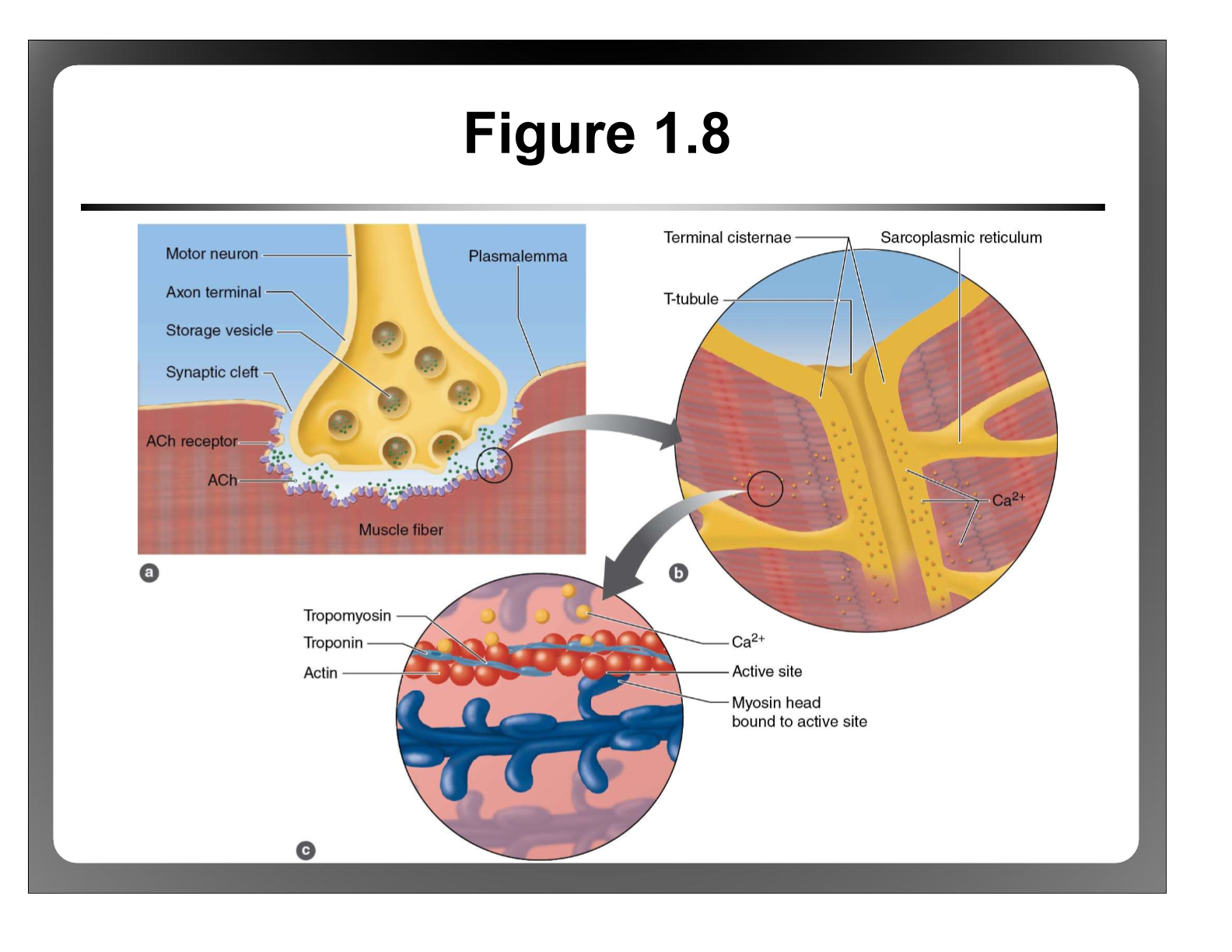
What is the Sliding filament theory
Relaxed:
No interaction occurs at the binding site
Myofilaments overlap a bit
Contraction:
Myosin head pulls actin to the center of sarcomere (Powe rstroke)
Filaments slide past each other
Everything shortens
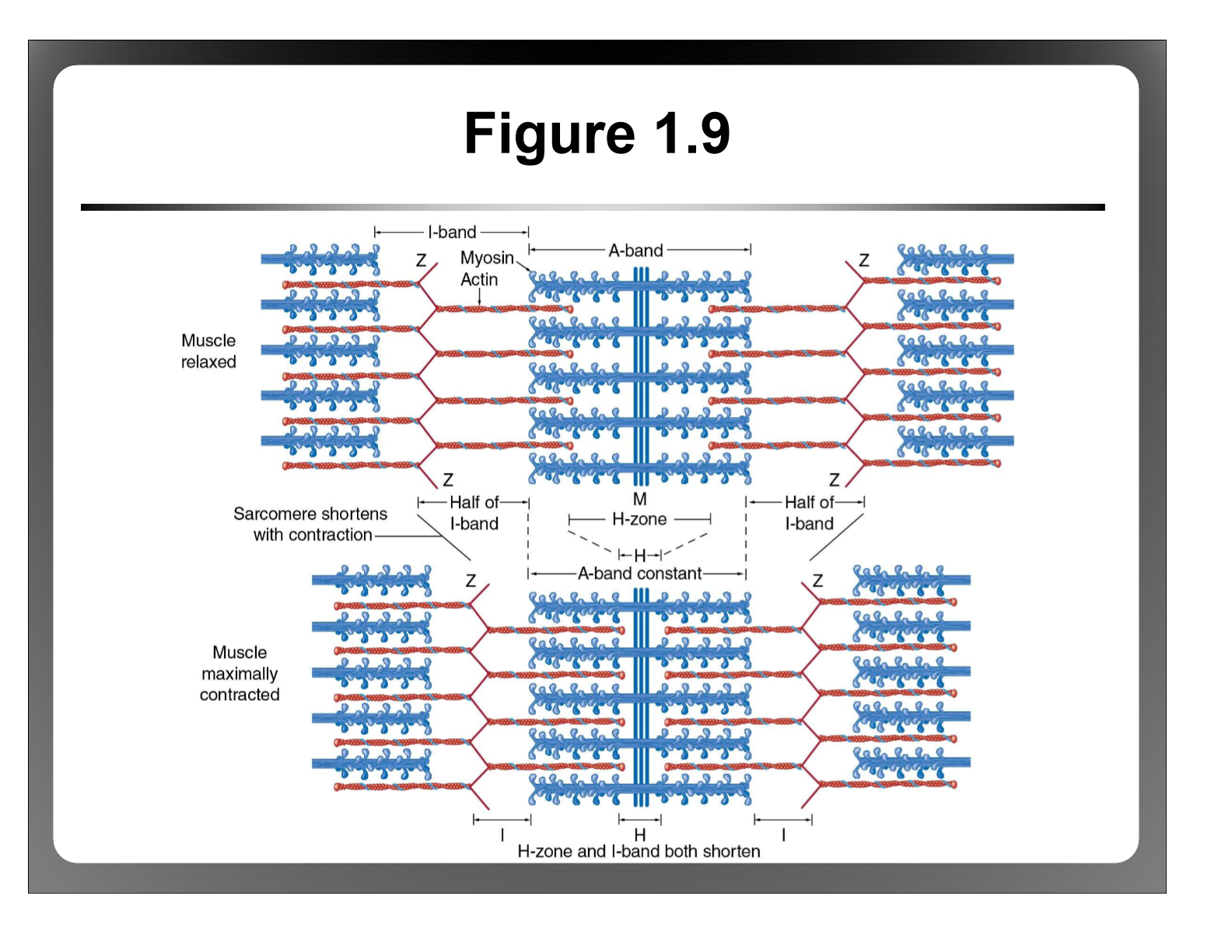
What happens when the power stroke ends?
Myosin detaches
Myosin goes back to original position and moves down to another active site
Process continues until Z-Disk reaches myosin filaments or AP stops
How does a muscle return to its resting length
AP Stops
Calcium is pumped back into sarcoplasmic reticulum
What are the muscle fiber types
Type 1 and Type 2
What is Type 1 muscle fiber
About 50% of fibers in the muscle
Slow twitch muscle
<300 fibers due to smaller neuron
What is a Type 2 muscle? What are the classifications of it
Fast twitch
2 types
Type 2a (25%)
Type 2x (25%)
>300 due to larger neuron
What is a twitch speed muscle
What is the oxidative vs glycolytic
What are the fatigue rates of each muscle
Type 2x → Fast then rapid decline
Type 2a → Medium force then rapid decline
Type 1 → Slow build, slow decline
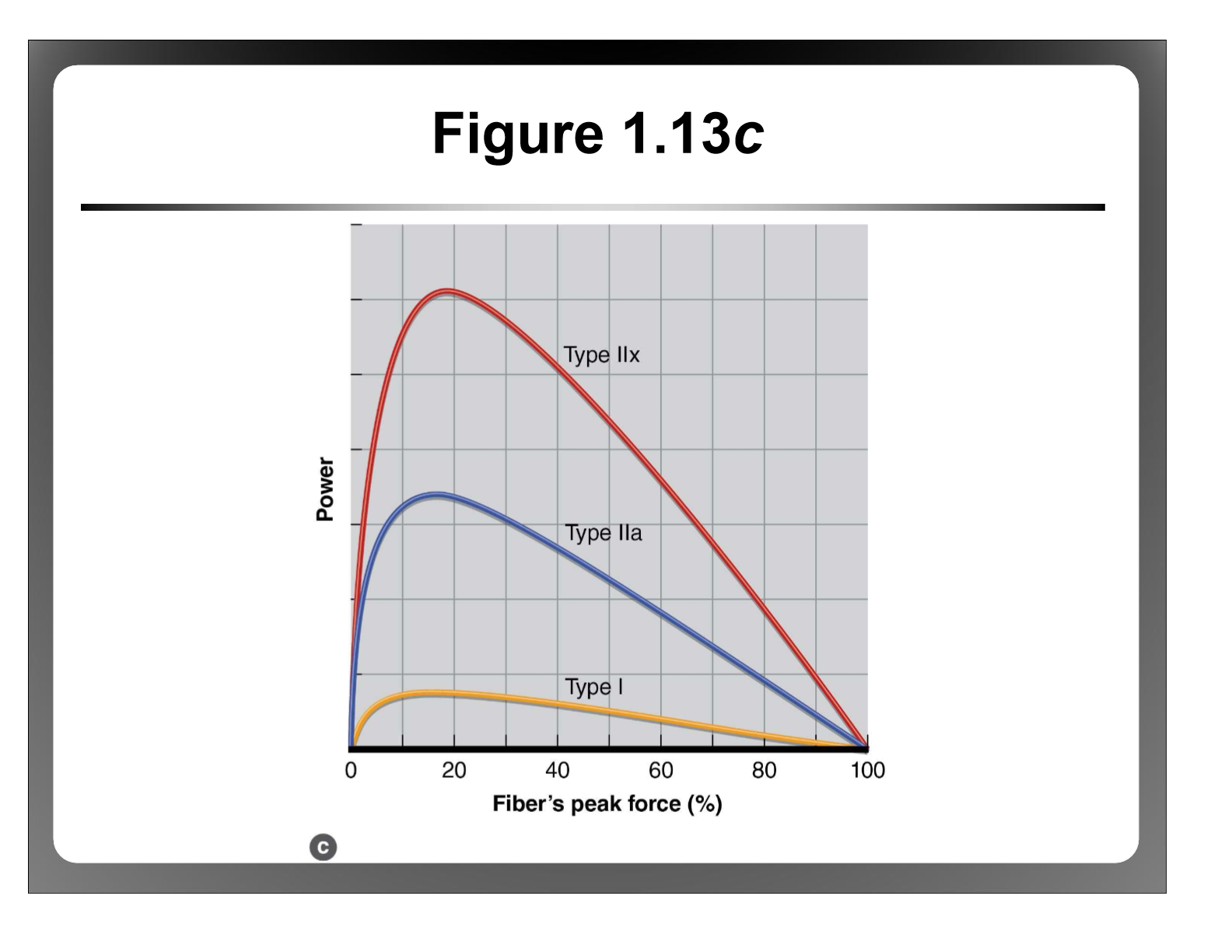
Describe Motor Units, what happens when we alter the force?
Method for altering force production
Less force = Less motor units
More force = More motor units
What are fiber determinants
Genetics, training , aging, and any possible influence from the nervous system
How is each fiber typed influence an athlete
Type 2 fatigue quickly
Type 2a → Short, intense endurance
Type 2x → Short explosive sprints
Type 1 is used in endurance training
What is a static muscle contraction
Muscle produce a lot of force but don’t change length
Joint angle doesn’t change
No sliding filaments
What is a dynamic muscle contraction
Muscle produces force and changes length
Joint movement occurs
What is the length-tension relationship and pennation angle will influence for production
Optimal sarcomere length equals optimal overlap
If it is too short or over stretched, then little to no force is developed
What is the CNS
Central nervous system
Contains Brain and spinal cord
What is the PNS
Sensory (Afferent) → Incoming
Motor (Efferent) → Outgoin
Somatic: Voluntary
Autonomic: Involuntary
Sympathetic
Parasympathetic:
Know the basic structure of a neuron
3 regions
Cell body → Nucleus
Dendrites → Receives information
Axon → Sends signals

What’s the purpose of a neuron
Send and receives different signals
What is the purpose of the Sodium-Potassium pump
Maintains the resting membrane potential of the neuron and creates the concentration difference in the cell
3 Ka+ in
2 Ca2+ out
How is an action potential created
When the Graded potential either excites or inhibits the neuron into an Action potential
Needs to cross the All-Or-Nothing Complex (-50mV)
What is an absolute refractory period
Neuron is unable to respond to another stimulus
What is a relative refractory period
Neuron only responds to a very strong stimulus
How is a neurotransmitter used during exercise
ACh stimulates skeletal muscle contraction, mediates the parasympathetic NS effects
Norepinephrine mediates sympathetic NS effect
What neurotransmitter is important for exercise
Endorphins
What parts of the brain deal with exercise
Frontal → Motor control, general thought
Temporal → auditory processing and interpretation
Parietal → General sensory processing and interpretation
Occipital → Visual processing and interpretation
Insular → Emotion and self-perception
Which regions of the brain are important for exercise physiology
Frontal Lobe, Basal Ganglia, and Parietal Lobe
What are the two major divisions of the PNS
Sensory and Motor
What are the major families of sensory receptors
Mechanoreceptors → Pressure, touch, vibration, stretch
Thermoreceptors → Heat
Nociceptors → Pain
Photoreceptors → Light
Chemoreceptors → Chemical stimulus
What is the somatic nervous system
Stimulates skeletal muscle
What is the autonomic nervous system?
Regulates visceral muscle (smooth muscle)
What is the sympathetic nervous system
Fight, Flight, Fawn, Freeze
What is the parasympathetic nervous system?
Rest and Digest